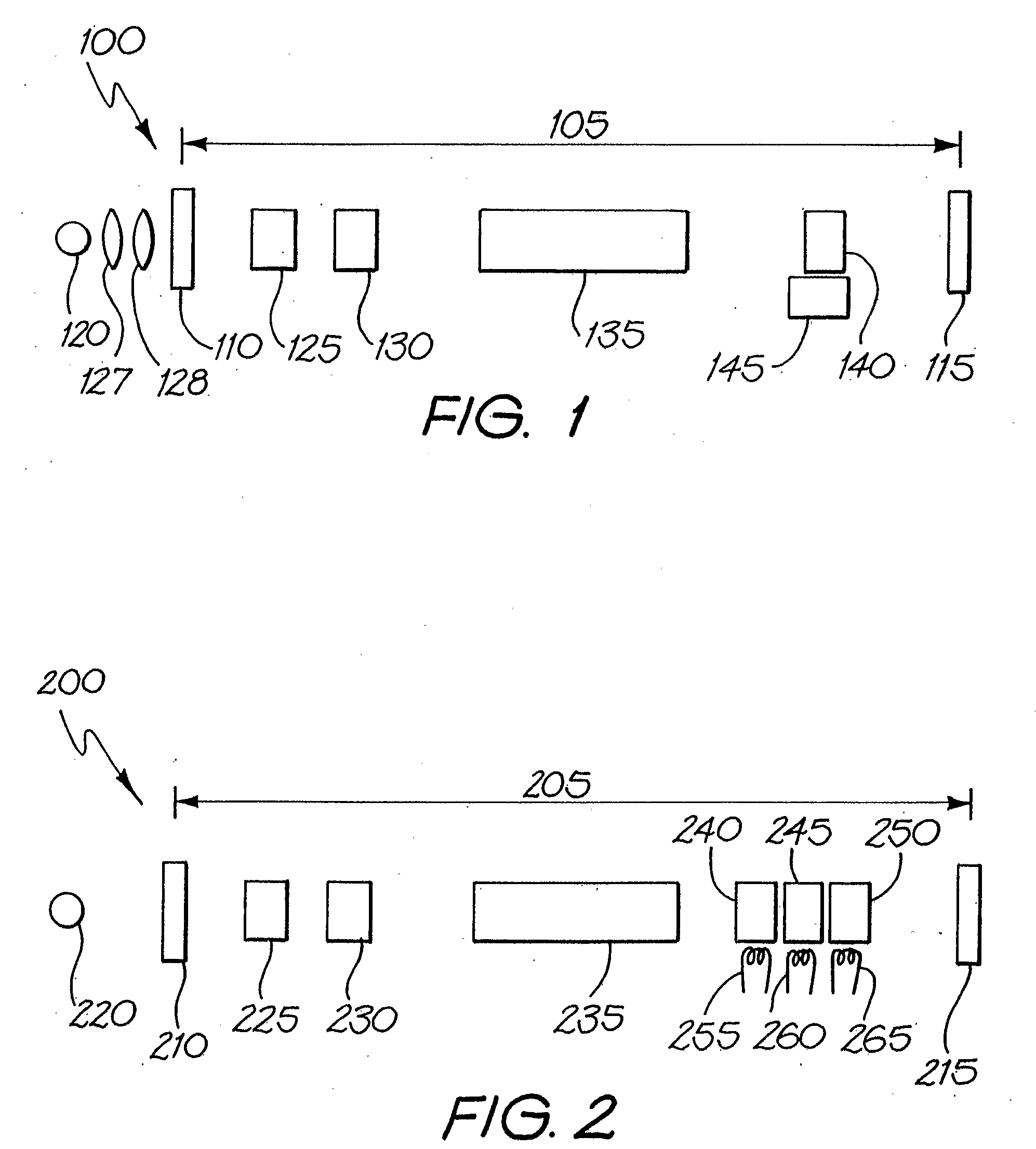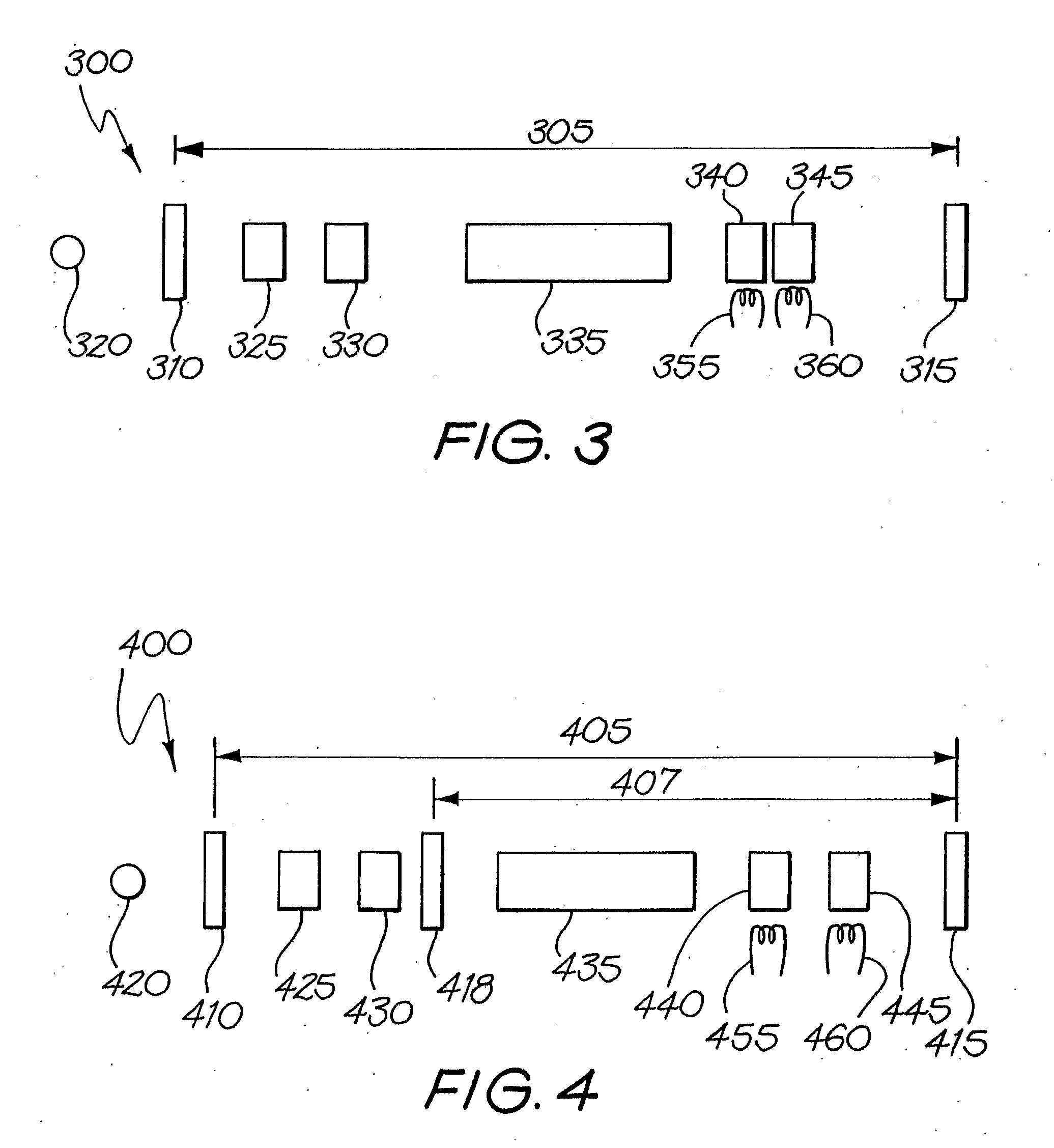Slectable Multiwavelength Laser for Outputting Visible Light
a laser system and multi-wavelength technology, applied in the direction of laser details, optical resonator shape and construction, basic electric elements, etc., can solve the problems of lithium iodate having limited utility in high-power applications, unable to optimise the position of that crystal, and substantial beam displacement due to refraction when the crystal is refraction
- Summary
- Abstract
- Description
- Claims
- Application Information
AI Technical Summary
Benefits of technology
Problems solved by technology
Method used
Image
Examples
example 1
[0215]FIG. 5 shows an experimental setup for a selectable laser system 500 according to the present invention. In FIG. 5, a bent cavity 510 is defined by a reflective face 515 on a laser material 535 and reflectors 520 and 525. The reflective face 515 is transmissive at 808 nm, and reflective at all cavity wavelengths (ie 532 nm, 555 nm, 579 nm, 1064 nm and 1158 nm). The reflector 525 is a 20 cm radius of curvature dielectric mirror which is reflective at all cavity wavelengths, and the reflector 520 is a flat dichroic mirror which is transmissive between the visible wavelengths of 532 nm (green) and 579 nm (yellow), and reflective at other cavity wavelengths (between 1064 nm and 1158 nm). With the exception of the reflective face 515, all faces of components 535, 540, 545, 550 and 555 are antireflection coated between 1064 nm and at 1158 nm. Arrow 530 represents a pump beam with a wavelength of 808 nm, which can cast a 0.2 mm spot on the laser material 535 with a power of about 22 ...
example 2
[0222]FIG. 6 shows an experimental setup for a selectable laser system 600 according to the present invention. In FIG. 6, a bent cavity 610 is defined by a reflective face 615 on a laser material 635 and reflectors 620 and 625. The reflective face 615 is transmissive at 808 nm, and reflective at all cavity wavelengths (ie 532 nm, 555 nm, 579 nm, 1064 nm and 1158 nm). The reflector 625 is a 20 cm radius of curvature dielectric mirror which is reflective at all cavity wavelengths, and the reflector 620 is a flat dichroic mirror which is transmissive at the visible wavelengths of 532 nm (green), 555 nm (lime) and 579 nm (yellow), and reflective at other cavity wavelengths (1064 nm and 1158 nm). With the exception of the reflective face 615, all faces of components 635, 640, 645 and 650 are antireflection coated at 1064 nm and at 1158 nm. Arrow 630 represents a pump beam with a wavelength of 808 nm, which can cast a 0.2 mm spot on the laser material 635 with power of about 22 W. The las...
example 3
[0240]A Raman laser, comprising a fibre-coupled diode, Nd:YAG laser crystal and KGd(WO4)2 crystal, and in addition an AO Q-switch and non-linear crystal, was constructed to demonstrate wavelength selectability. Wavelength selectability has been demonstrated using angle-tuning of LBO, angle-tuning of BBO, and temperature tuning of LBO. For temperature tuning LBO, two crystals, LBO1 (=0, =0) and LBO2 (=0, =5), were used because the range of temperatures required for a single LBO crystal was too high. The key results are summarised below.
TABLE CPhase-matching532 nm555 nm579 nm606 nm636 nmLBO angle-tune1.7 W0.95 W1.8 W——LBO temp-tune1.5 W0.52 W0.57 W 0.2 W—BBO angle-tune1.3 W0.45 W1.0 W0.25 W0.04 W
[0241]The highest output powers were obtained by angle tuning of LBO, however the relatively large tuning range limited the number of output wavelengths. Temperature tuning of LBO has an advantage that cavity mirror re-alignment is not required and wavelength selection is easily controlled el...
PUM
 Login to View More
Login to View More Abstract
Description
Claims
Application Information
 Login to View More
Login to View More - R&D
- Intellectual Property
- Life Sciences
- Materials
- Tech Scout
- Unparalleled Data Quality
- Higher Quality Content
- 60% Fewer Hallucinations
Browse by: Latest US Patents, China's latest patents, Technical Efficacy Thesaurus, Application Domain, Technology Topic, Popular Technical Reports.
© 2025 PatSnap. All rights reserved.Legal|Privacy policy|Modern Slavery Act Transparency Statement|Sitemap|About US| Contact US: help@patsnap.com



